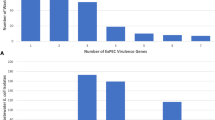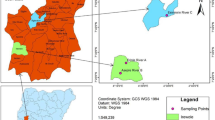Abstract
We investigated the fate of Escherichia coli in natural waters, addressing survival, viable but non-culturable (VBNC) state, changes in phenotype and genomic diversification under laboratory microcosm environment. Five E. coli isolates (three marine, one clinical and one laboratory strain) were inoculated in microcosms of sterile distilled water, as well as, water collected from river, pond, sea, and estuary. A viable count was measured every week for up to 33 weeks. Strains which undergone VBNC state in microcosms were resuscitated. The revived isolates were tested to determine changes in antibiotic susceptibility, thermotolerance and genetic fingerprinting. We found extended persistence of five E. coli strains in water microcosms at room temperature for durations ranging from four to 33 weeks. Even in distilled water, some isolates persisted up to seven weeks; proving E. coli have excellent tenacity to survive. At VBNC state in microcosms, bacteria were small coccoid in shape and formed biofilms in most cases. Resuscitated laboratory strains showed changes in antibiotic susceptibility and thermotolerance compared to the original counterpart. However, the revived marine isolates showed very little to no difference in those tests. Resuscitation media could not revived the pathogenic isolates. The REP- and BOX-PCR genomic fingerprinting also showed some genetic diversification among resuscitated strains during the extended survival and VBNC state. The overall observation supports for the E. coli to survive in natural waters and to enter into VBNC state. It ultimately proves that their presence in water does not necessarily indicate faecal contamination but still beyond acceptance.






Similar content being viewed by others
REFERENCES
Ahmed, W., Neller, R., and Katouli, M., Host species-specific metabolic fingerprint database for enterococci and Escherichia coli and its application to identify sources of fecal contamination in surface waters, Appl. Environ. Microbiol., 2005, vol. 71, pp. 4461–4468.
Akter, S., Islam, M., Afreen, K.S., Azmuda, N., Khan, S.I., and Birkeland, N.K., Prevalence and distribution of different diarrhoeagenic Escherichia coli virulotypes in major water bodies in Bangladesh, Epidemiol. Infect., 2013, vol. 141, pp. 2516–2525.
Arana, I., Orruno, M., Perez-Pascual, D., Seco, C., Muela, A., and Barcina, I., Inability of Escherichia coli to resuscitate from the viable but nonculturable state, FEMS Microbiol. Ecol., 2007, vol. 62, pp. 1–11.
Bauer, A.W., Kirby, W.M., Sherris, J. C., and Turck, M., Antibiotic susceptibility testing by a standardized single disk method, Am. J. Clin. Pathol., 1966, vol. 45, pp. 493–496.
Byappanahalli, M.N. and Fujioka, R.S., Evidence that tropical soil environment can support the growth of Escherichia coli, Water Sci. Technol., 1998, vol. 38, pp. 171–174.
Byappanahalli, M.N., Whitman, R.L., Shively, D.A., Sadowsky, M.J., and Ishii, S., Population structure, persistence, and seasonality of autochthonous Escherichia coli in temperate, coastal forest soil from a Great Lakes watershed, Environ. Microbiol., 2006, vol. 8, pp. 504–513.
Cabral, J.P., Water microbiology. Bacterial pathogens and water, Int. J. Environ. Res. Public Health, 2010, vol. 7, pp. 3657–3703.
Ding, T., Suo, Y., Xiang, Q., Zhao, X., Chen, S., Ye, X., and Liu, D., Significance of viable but nonculturable Escherichia coli: induction, detection, and control, J. Microbiol. Biotechnol., 2017, vol. 27, pp. 417–428.
Doran, J.W. and Linn, D.M., Bacteriological quality of runoff water from pastureland, Appl. Environ. Microbiol., 1979, vol. 37, pp. 985–991.
Edwards, P.R. and Ewing, W.H., Edwards and Ewing’s Identification of Enterobacteriaceae, New York: Elsevier, 1986, 4th ed.
El-Leithy, M.A., El-Shatoury, E.H., Abou-Zeid, M.A., Hemdan, B.A., Samhan, F.A., and El-Taweel, G.E., Survival of enterotoxigenic E. coli O157:H7 strains in different water sources, Int. J. Environ., 2014, vol. 3, pp. 212–220.
Ercumen, A., Pickering, A.J., Kwong, L.H. Arnold, B.F., Parvez, S.M., Alam, M., Sen, D., Islam, S., Kullmann, C., Chase, C., Ahmed, R., Unicomb, L., Luby, S.P., and Colford, J.M., Animal feces contribute to domestic fecal contamination: evidence from E. coli measured in water, hands, food, flies, and soil in Bangladesh, Environ. Sci. Technol., 2017, vol. 51, pp. 8725–8734.
Flint, K.P., The long-term survival of Escherichia coli in river water, J. Appl. Bacteriol., 1987, vol. 63, pp. 261–270.
Herigstad, B., Hamilton, M., and Heersink, J., How to optimize the drop plate method for enumerating bacteria, J. Microbiol. Methods, 2001, vol. 44, pp. 121–129.
Ishii, S., Ksoll, W.B., Hicks, R.E., and Sadowsky, M.J., Presence and growth of naturalized Escherichia coli in temperate soils from Lake Superior watersheds, Appl. Environ. Microbiol., 2006, vol. 72, pp. 612–621.
Ishii, S. and Sadowsky, M.J., Escherichia coli in the environment: implications for water quality and human health, Microbes Environ., 2008, vol. 23, pp. 101–108.
Kolling, G., Wu, M., and Guerrant, R.L., Enteric pathogens through life stages, Front. Cell. Infect. Microbiol., 2012, vol. 2, p. 114.
Liu, D., Escherichia coli, Encyclopedia of Microbiology, 4th ed., Schmidt, T.M., Ed., Academic, 2014, pp. 171–182.
Luby, S.P., Halder, A.K., Huda, T.M., Unicomb, L., Islam, M.S., Arnold, B.F., and Johnston, R.B., Microbiological contamination of drinking water associated with subsequent child diarrhea, Am. J. Trop. Med. Hyg., 2015, vol. 93, pp. 904–911.
Macfarlane, G.T. and Macfarlane, S., Human colonic microbiota: ecology, physiology and metabolic potential of intestinal bacteria, Scand. J. Gastroenterol. Suppl., 1997, vol. 222, pp. 3–9.
Marion, J.W., Lee, J., Lemeshow, S., and Buckley, T.J., Association of gastrointestinal illness and recreational water exposure at an inland U.S. beach, Water Res., 2010, vol. 44, pp. 4796–4804.
McLarnan, S.M., Escherichia coli as a water quality indicator organism: a case for responsive, science-based policy, All College Thesis Program, 2016−2019. https://digitalcommons.csbsju.edu/honors_thesis/38.
Medema, G.J., Payment, P., Dufour, A., Robertson, W., Waite, M., Hunter, P., Kirby, R., and Anderson, Y., Safe drinking water and ongoing challenge, in Assessing Microbial Safety of Drinking Water: Improving Approaches and Methods, Dufour, A., Snozzi, M., Koster, W., Bartram, J., and Ronchi, E., Eds., London: WHO & OECD, IWA, 2003, pp. 11–45.
Nautiyal, C.S., Self-purificatory Ganga water facilitates death of pathogenic Escherichia coli O157:H7, Curr. Microbiol., 2009, vol. 58, pp. 25–29.
Nguyen, M.T., Jasper, J.T., Boehm, A.B., and Nelson, K.L., Sunlight inactivation of fecal indicator bacteria in open-water unit process treatment wetlands: modeling endogenous and exogenous inactivation rates, Water. Res., 2015, vol. 83, pp. 282–292.
Naoko, W., Junichiro, N., Jalaluddin, S., James, P.N., Jav, S., Mayumi, I., Kunihiro, M., Koichi, T., Masao, Y., and Yoshifumi, K., Quantitative biofilm assay using a microtiter plate to screen for enteroaggregative Escherichia coli, Am. J. Trop. Med. Hyg., 2004, vol. 71, no. 5, pp. 687–690.
Oliver, J.D., The viable but nonculturable state in bacteria, J. Microbiol., 2005, vol. 43, pp. 93–100.
Oram, B., Fecal Coliform Bacteria in Water, Water Res. Center, 2014.
Pavel, A.B. and Vasile, C.I., PyElph—a software tool for gel images analysis and phylogenetics, BMC Bioinform., 2012, vol. 13, p. 9.
Pienaar, J.A., Singh, A., and Barnard, T.G., The viable but non-culturable state in pathogenic Escherichia coli: a general review, Afr. J. Lab. Med., 2016, vol. 5, p. 368.
Pinto, D., Almeida, V., Almeida Santos, M., and Chambel, L., Resuscitation of Escherichia coli VBNC cells depends on a variety of environmental or chemical stimuli, J. Appl. Microbiol., 2011, vol. 110, pp. 1601–1611.
Pinto, D., Santos, M.A., and Chambel, L., Thirty years of viable but nonculturable state research: unsolved molecular mechanisms, Crit. Rev. Microbiol., 2015, vol. 41, pp. 61–76.
Rademaker, J.L.W. and Bruijn, F.J.D., Characterization and classification of microbes by rep-PCR genomic fingerprinting and computer assisted pattern analysis, DNA Markers: Protocols, Applications and Overviews, Caetano-Anollés G. and Gresshoff P.M., Eds., New York: Wiley, 1998, ch. 10, pp. 151–171.
Rao, L., Wang, Y., Chen, F., and Liao, X., The synergistic effect of high pressure CO2 and nisin on inactivation of Bacillus subtilis spores in aqueous solutions, Front. Microbiol., 2016, vol. 7, p. 1507.
Robins-Browne, R.M., Holt, K.E., Ingle, D.J., Hocking, D.M., Yang, J., and Tauschek, M., Are Escherichia coli pathotypes still relevant in the era of whole-genome sequencing?, Front. Cell. Infect. Microbiol., 2016, vol. 6, p. 141.
Sata, S., Fujisawa, T., Osawa, R., Iguchi, A., Yamai, S., and Shimada, T., An improved enrichment broth for isolation of Escherichia coli O157, with specific reference to starved cells, from radish sprouts, Appl. Environ. Microbiol., 2003, vol. 69, pp. 1858–1860.
Savageau, M.A., Escherichia coli habitats, cell types, and molecular mechanisms of gene control, Am. Nat., 1983, vol. 122, pp. 732–744.
Sousa, C.P., The versatile strategies of Escherichia coli pathotypes: a mini review, J. Venom. Anim. Toxins Incl. Trop. Dis., 2006, vol. 12, pp. 363–373.
Swaroop, S., The range of variation of the most probable number of organisms estimated by the dilution method, Indian J. Med. Res., 1951, vol. 39, p. 107.
Walker, T.J., Bachoon, D.S., Otero, E., and Ramsubhag, A., Detection of verotoxin producing Escherichia coli in marine environments of the Caribbean, Mar. Pollut. Bull., 2013, vol. 76, pp. 406–410.
Wellington, E.M., Boxall, A.B., Cross, P. Feil, E.J., Gaze, W.H., Hawkey, P.M., Johnson-Rollings, A.S., Jones, D.L., Lee, N.M., and Otten, W., The role of the natural environment in the emergence of antibiotic resistance in gram-negative bacteria, Lancet Infect. Dis., 2013, vol. 13, pp. 155–165.
WHO, International Standards for Drinking-Water [Electronic Resource]: Annex II, Table 1, Geneva: World Health Organization, 1958. WHO, Multiple-tube method for thermotolerant (faecal) coliforms, Guidelines for Drinking Water Quality: Surveillance and Control of Community Supplies (book 3), Geneva: World Health Organization, 1998.
WHO, Guidelines for Drinking-water Quality [Electronic Resource]: Incorporating 1st and 2nd Addenda, Geneva: World Health Organization, 2008. WHO, Drinking-Water, Geneva: World Health Organisation, 2018.
WHO, Enterohaemorrhagic Escherischia coli, Geneva: World Health Organisation, 2019.
Winfield, M.D. and Groisman, E.A., Role of nonhost environments in the lifestyles of Salmonella and Escherichia coli, Appl. Environ. Microbiol., 2003, vol. 69, pp. 3687–3694.
Zhao, X., Zhong, J., Wei, C., Lin, C.W., and Ding, T., Current perspectives on viable but non-culturable state in foodborne pathogens, Front. Microbiol., 2017, vol. 8, p. 580.
ACKNOWLEDGMENTS
We are indebted to Nowshin Nusrat, Dipon Kundu and S.M. Shajidur Rahman for essential help in field and laboratory work.
Funding
This study was funded by the Higher Education Quality Enhancement Project (HEQEP), Academic Innovation Fund (AIF) 3rd round sub-project (CP 3400).
Author information
Authors and Affiliations
Corresponding author
Ethics declarations
The authors declare that they have no conflict of interest. This article does not contain any studies involving animals or human participants performed by any of the authors.
Supplementary Information
Rights and permissions
About this article
Cite this article
Saima, U., Alam, M. & Akter, S. Survival of escherichia coli in Water Microcosm Study and Rethinking its Use as Indicator. Microbiology 90, 247–260 (2021). https://doi.org/10.1134/S0026261721020107
Received:
Revised:
Accepted:
Published:
Issue Date:
DOI: https://doi.org/10.1134/S0026261721020107




